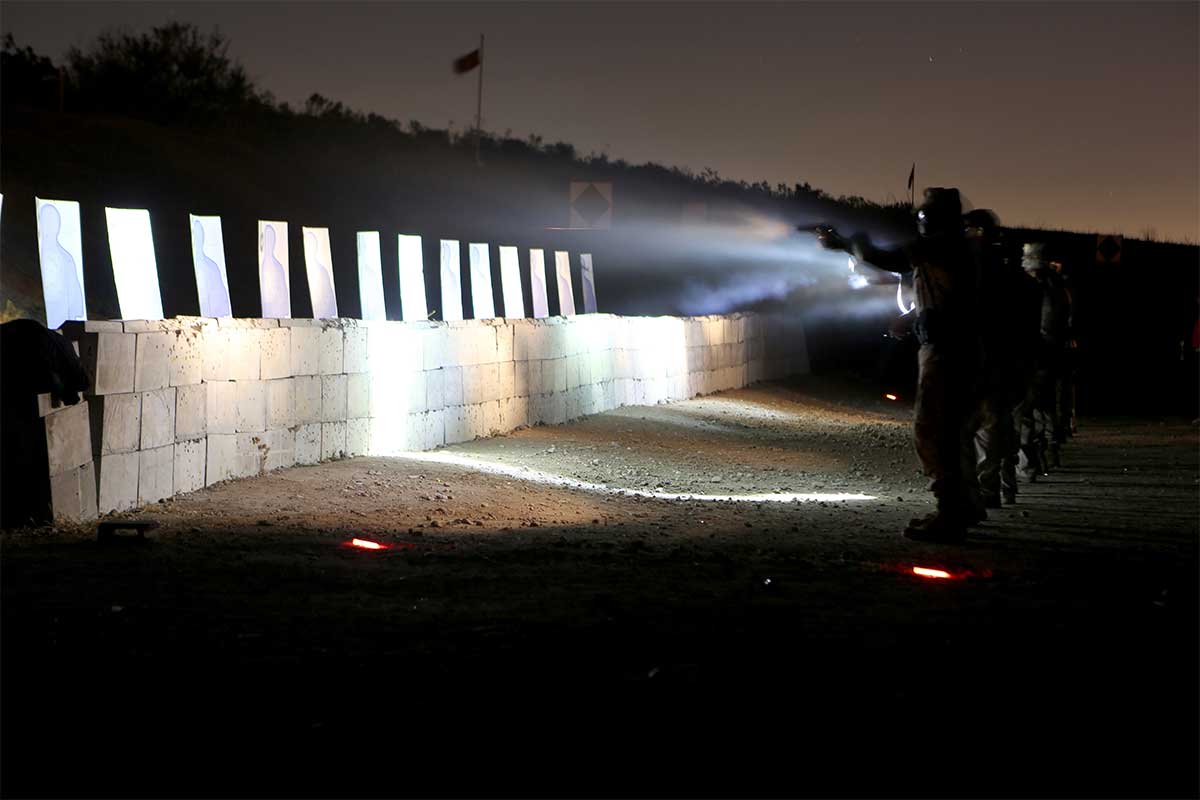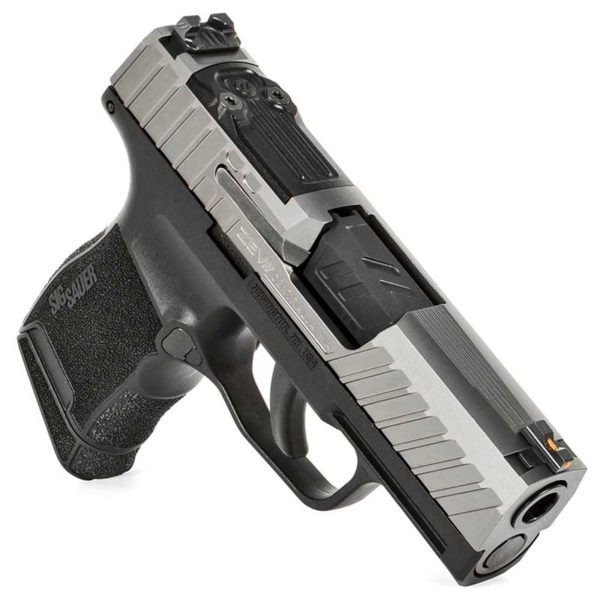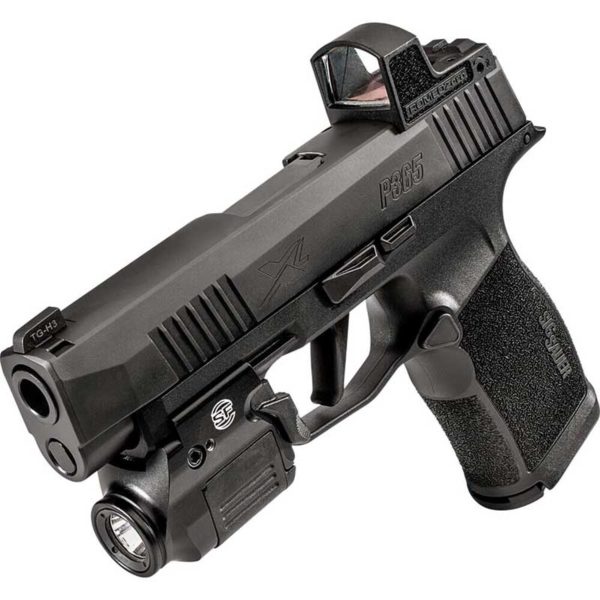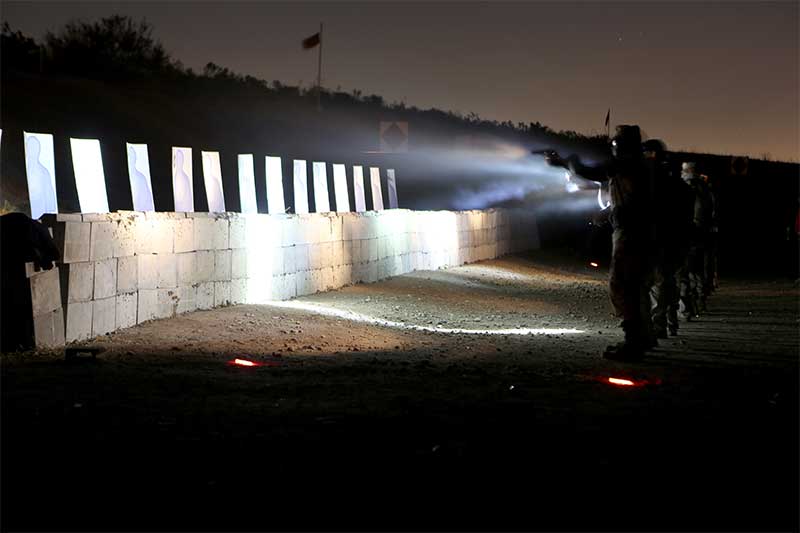
AC-112421-NS-4-800
A five-year study of “California Peace Officers Killed and Assaulted in the Line of Duty,” published by the California Commission on Peace Officer Standards and Training (POST) in November 2001 found that most officer-involved shootings occur within the first two minutes of the officer arriving on scene with no time for visual adaption to low light.
The study also found that 70 percent of the shootings occurred during the hours of darkness. Lighting was a contributing factor, according to 39 percent of the officers. The national statistics compiled by the FBI are similar.
TRITIUM NIGHT SIGHTS
Self-illuminating night sights have been available for over 50 years. The first U.S. Patent for “Radioluminescence Gunsight and Method” was issued in 1972 to Julio Santiago and Eliott Knudsen. Many handguns now come equipped with night sights or are available as a factory option.
Tritium sights contain special radioluminescence inserts. These consist of small glass capsules filled with tritium, a radioactive isotope of hydrogen. The inner walls of the capsules are coated with a phosphor compound.
Beta particles (electrons) are emitted as the tritium decays. They strike the phosphor particles on the inside of the glass, exciting the phosphor particles and causing them to emit visible light. No external power or exposure to light is required. Tritium sights are dependable and insensitive to temperature.
The color of the light emitted is determined by the type of phosphor that’s employed. Green, yellow and orange light emitting capsules are available. Green appears to be the brightest color to the human eye. This is why night vision goggles and scopes employ green phosphor. Yellow and orange aren’t as bright, with orange being the dimmest of the available colors.

SIG Sauer P320 RXP Compact 9mm pistol with X-RAY3 3-Dot Tritium Day/Night Suppressor Height sights and ROMEOPro MRDS installed. The super-tall sights allow co-witnessing with red dot opti and serve as backup.
Although other colors could be provided, they would be too dim to the eye to be practical. Green also provides the greatest contrast from muzzle flash.
Tritium sights are available in a variety of fixed- and adjustable-sight models. Both three-dot systems and bar-dot systems are available. Green three-dot systems are the most common, however many shooters prefer two-color sights with green front and yellow rear dots.
The use of two colors provides more distinction between the front and rear sights and helps avoid the possibility of momentary confusion as to which dot is which. Many shooters also find that two-color night sights make it easier for them to concentrate on front sight in low-light conditions, aiding accuracy.
Everything else being equal, all tritium sights have the same life irrespective of the manufacturer. Tritium has a half-life (the time required for half of the tritium to decay) of 12.3 years. The brightness of the capsules will diminish over time as the tritium decays. From a practical standpoint, the sights may remain serviceable for up to 15 years.
The radiation emitted is minuscule. It’s classified by the NRC as “below regulatory concern.” Even if the capsules were to rupture, there wouldn’t be any hazard. The beta radiation emitted by tritium is unable to penetrate the human skin. Even a thin sheet of paper completely blocks it.
A typical three-dot tritium night sight contains approximately 50 millicuries (mCi) of tritium. Ten thousand tritium sight capsules would have to simultaneously rupture in a small room to potentially pose a radiation health risk.
PHOTOLUMINESCENT SIGHTS
Photoluminecent sights are another category of night sights. Photoluminescent sights require activation by either sunlight or an artificial light source. Think of them like a rechargeable battery. Super-LumiNova®, a strontium aluminate oxide pigment, is the brightest photoluminescent pigment.
While Super-LumiNova is often quite bright immediately after exposure to light and doesn’t suffer any practical aging, the luminescence diminishes rapidly and is gone within a few hours after exposure. If the pigment is activated by artificial light, luminescent output is often 1/10 of that from activation by sunlight.
FIBER OPTIC SIGHTS
Night sights need to be distinguished from fiber optic sights. Fiber optic sights are designed to create contrast between the target and sight with bright color. For this reason, they are popular with many hunters. Fiber optic sights rely upon ambient light. While the light gathering capabilities of the fiber optics can brighten the sights in daylight and as dusk or dawn and in so doing hasten target acquisition, fiber optic sights should be considered daylight sights, unless there is supplemental illumination of the sight.
HYBRID SIGHTS
Hybrid sights that combine photoluminescent pigment and tritium inserts are available. The photo-luminescent pigment increases visibility and hastens acquisition in low light levels before it’s dark enough to see the tritium.
Hybrid tritium fiber optic sights are also available. Tritium fiber optic sights combine both tritium and fiber optics. The tritium maintains the brightness of the sight in low light or no light conditions. The fiber optic enhances visibility in daylight by funneling ambient light.

ZEV Technologies ZEV Z365 Octane comes with RMSC optic cut and cover plate and ZEV Fiber Optic Combat Sights. Fiber optics are by themselves high-visibility day sights, although they could function as a quasi-night sight that aids in sight acquisition, depending on the lighting and if used in conjunction with a flashlight.

SIG Sauer P365 with ROMEOZero MRDS, X-RAY3 Tritium Day/Night Front Sight and SureFire XSC Micro-Compact WeaponLight. A weapon light is part of the weapon system and needs to be treated as such. It’s an adjunct to a flashlight and not a replacement for it.

XS Sights DXT2 Big Dot Night Sights are hybrid sights that utilize both photoluminescent pigment and tritium inserts.
TACTICAL NECESSITY?
To accurately aim a weapon, you need to be able to clearly see the sights—something that is often difficult or impossible to do with standard sights in low-light situations. Tritium sights have proven to be a valuable aid in delivering precise and accurate fire in low-light conditions. Tests that were conducted at the FBI Academy demonstrated an increase in night-firing accuracy of as much as 500 percent when tritium sights were used.
Statistics show that most shootings take place at distances of 20 feet or less. Many of the shootings may be classified as spontaneous shootings, where there was no warning and the weapon was in the holster at the outset. There’s often little or no time to see the sights (even if the sights would be visible), nor any real opportunity to use them.
A trained and practiced shooter shouldn’t have any trouble getting center-of-mass hits in low light at these short ranges, even with the ability to see or use the sights impaired. Every time a shooter draws and aims a handgun, the action becomes imprinted in the shooter’s mind. The conscious execution of skills eventually becomes subconscious and automatic. The sights are instinctively aligned. Little or no sight correction is needed.

Low light training. Having the right equipment is only part of the equation. Shooting is a perishable skill that requires practice to maintain. This is all the more true for shooting during low-light.
Something else to consider. A research study conducted by the Los Angeles Police Department found that officers have difficulty distinguishing between lethal and nonlethal objects in levels of light less than that produced by 0.5 foot candles—routine working conditions at night. Under these circumstances, you’ll need the illumination of a white light, irrespective of whether or not you have night sights.
Ambient light isn’t the only factor. Your visual acuity will be further reduced by the fact that you and your assailant will frequently be in motion prior to, and during, a shooting. The effects of stress and fear will also adversely affect visual acuity. Hormones secreted during periods of high stress or acute fear dramatically decrease visual functioning.
Do tritium sights improve hit ratios on the street? The answers aren’t clear-cut. Most officers involved in spontaneous shooting scenarios report either not using their sights or not remembering if they did.
When faced with a threat, the human mind instinctively focuses on the threat. The physiological effects of extreme stress can also make it difficult, if not impossible, for the eyes to get a clear sight picture.
This isn’t to say that tritium sights aren’t advantageous to have in close range, spontaneous shooting scenarios. They allow you to employ a flash sight picture in situations where it would be otherwise impossible due to low ambient lighting.
Where tritium sights really excel is in non-spontaneous shooting scenarios and at longer ranges in which the target is clearly identifiable and standard sights couldn’t be seen or wouldn’t be silhouetted against the target.
Cost aside, there’s no downside to night sights. They’re a valuable addition to any handgun.















